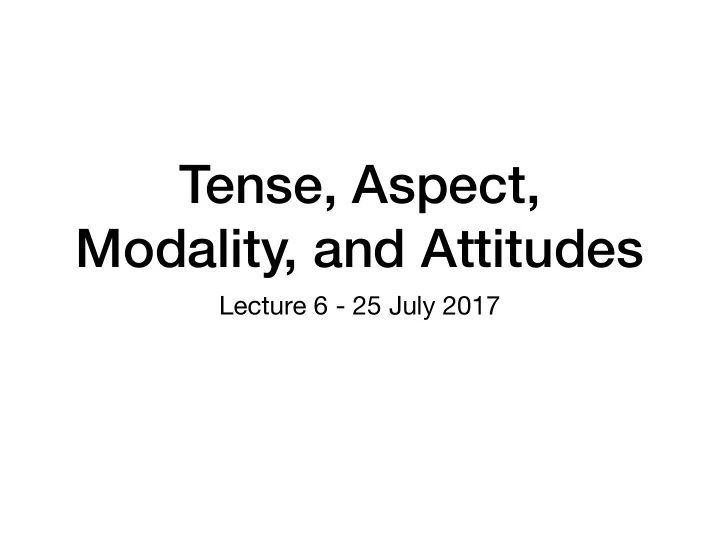

Tense, Aspect, Modality, and Attitudes Lecture 6 - 25 July 2017
Introduction Reminders: • Meanings of sentences express propositions: truth conditions on a (located, described) situation. • Meanings are essentially indexical, with parameters set in the context of use.
Introduction Reminders: • Entities: the most general notion of thing, including the notion of individuation. (Topology) • Mass vs. count • Parts of a whole • Eventualities: a second sort of entity. Many propositions can be construed as descriptions (presentations) of eventualities.
Introduction Reminders: • Quantification: • Conditions stated on a contextually restricted set of entities—the base of the quantification. • Conditions distinguished by force (e.g. universal vs. existential) Basketball players are all tall.
Introduction Generalizations: • Eventualities have a topology too. • They can and must be individuated and have parts. • Possible situations/worlds can be quantified over.
Tense and Aspect (Sentence aspect and Aktionsart)
The Reichenbach Framework • Tense marking on verbs understood as a system for locating described situation (event time)… • With respect to the context of use (speech time)… • Potentially relative to a perspective location (reference time).
Reference to Times In English
Structure of Eventualities • Aspectual classifications • Of verbs? • Of eventuality types? • Of sentences? • Sentence aspectual perspective vs. eventuality class
Aspectual Dimensions of Eventualities • States vs. Events • Static holds: uniform, without bounding, internal point of reference. • Dynamic Happenings: involve change, bounded, point of reference may be internal or external.
Aspectual Dimensions of Durative Events • Durative: last for a period of time, internal point of reference • Homogenous, extensible with no inherent endpoint ATELIC Activities. ( Running, eating, singing ) • Process with a natural culmination TELIC Accomplishments ( running a mile, eating an apple, singing a song )
Aspectual Dimensions of Punctual Events • Punctual: presented as instantaneous wholes from an external point of reference • Repeatable, to create an activity. ( Hopping ) Semelfactives • Transitions to a resultant state. ( Arriving ) Achievements
Diagnostic Tests • English simple present tense (stative vs. habitual) • In an hour vs. For an hour • X is Ving entails that X has Ved
Modality as Quantification Over Possible Worlds • Existential vs. Universal force • The restriction/base of the modal quantification • A general restriction on the relevant worlds: epistemic, deontic, … • More detailed conditions on how worlds are compared (ordering and accessibility relations) • Analysis involves fixing type of modal base and force first, then getting into the weeds
Cross category modality • possible, necessary, probable, likely, required, optional • Possibly, necessarily, probably, likely, perhaps • Can, could, may, might, should, shall, must
Propositional Attitudes • Relations between individuals and propositions • The holder of the attitude is central to establishing the modal base Believe, hope, want, suspect, find out, fear, doubt, regret
Mood/Mode • Presumptions anchored by the context of use (“the real world”) • Realis vs. Irrealis • Indicative vs. Subjunctive and Conditional • Counterfactual • The future is inherently modal (A cautionary tale)
Questions and Discussion
Recommend
More recommend